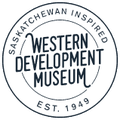
Language is important. The words we choose to use in our public spaces and our historical interpretation must be inclusive, respectful, current, historically accurate and meaningful. Language also changes with time. What were acceptable narratives, framings and interpretations in the past are now often not, considering new research, changing demographics and public engagement and expectations. This is especially relevant since the findings of the Truth and Reconciliation Commission of Canada were released in 2015. Curating museum content requires making choices. Choices about the kind of interpretations we present. Choices about what to include and what gets left out. Choices about the kinds of messages we are sending to visitors. Today, we are choosing to revisit, review and renew those past content choices in all four of our exhibit locations – North Battleford, Moose Jaw, Saskatoon and Yorkton.
You might have noticed some of our staff out in the galleries, reading and evaluating signs and texts. That’s because the WDM has launched a systematic evaluation of the language used in its galleries. The text in our galleries might have been produced in the early days of the Museum, dating back as far as the 1950s, to as recently as this year. Did you know we have 200,000 square feet of indoor exhibit space? That number does not include our outdoor exhibits. The WDM is physically one of the largest museums in Canada. As such, we have thousands of signs, artifact labels, interpretive panels and historical interpretations in our spaces that are under review.

